
eBook - ePub
Basic Drawing
Louis Priscilla
This is a test
Compartir libro
- 128 páginas
- English
- ePUB (apto para móviles)
- Disponible en iOS y Android
eBook - ePub
Basic Drawing
Louis Priscilla
Detalles del libro
Vista previa del libro
Índice
Citas
Información del libro
Unique in its presentation, Basic Drawing teaches by example. Through a profusion of self-explanatory drawings, simple rules of procedure are expertly illustrated for artists, enabling them to build a solid foundation in all aspects of art composition.
Presenting informative facts rather than ideology, the author begins with perspective and progresses to the figure in movement; light and shade; and detailed anatomy such as the head, neck, facial features, back, hips, legs, feet, arms, and hands. Using hundreds of masterful illustrations from his own portfolio, Priscilla continues with drapery, composition, and trees and landscape, including outdoor sketching. A truly all-in-one manual that belongs on every artist's bookshelf, Basic Drawing outlines the fundamental skills of drawing with an effective and powerful simplicity.
Presenting informative facts rather than ideology, the author begins with perspective and progresses to the figure in movement; light and shade; and detailed anatomy such as the head, neck, facial features, back, hips, legs, feet, arms, and hands. Using hundreds of masterful illustrations from his own portfolio, Priscilla continues with drapery, composition, and trees and landscape, including outdoor sketching. A truly all-in-one manual that belongs on every artist's bookshelf, Basic Drawing outlines the fundamental skills of drawing with an effective and powerful simplicity.
Preguntas frecuentes
¿Cómo cancelo mi suscripción?
¿Cómo descargo los libros?
Por el momento, todos nuestros libros ePub adaptables a dispositivos móviles se pueden descargar a través de la aplicación. La mayor parte de nuestros PDF también se puede descargar y ya estamos trabajando para que el resto también sea descargable. Obtén más información aquí.
¿En qué se diferencian los planes de precios?
Ambos planes te permiten acceder por completo a la biblioteca y a todas las funciones de Perlego. Las únicas diferencias son el precio y el período de suscripción: con el plan anual ahorrarás en torno a un 30 % en comparación con 12 meses de un plan mensual.
¿Qué es Perlego?
Somos un servicio de suscripción de libros de texto en línea que te permite acceder a toda una biblioteca en línea por menos de lo que cuesta un libro al mes. Con más de un millón de libros sobre más de 1000 categorías, ¡tenemos todo lo que necesitas! Obtén más información aquí.
¿Perlego ofrece la función de texto a voz?
Busca el símbolo de lectura en voz alta en tu próximo libro para ver si puedes escucharlo. La herramienta de lectura en voz alta lee el texto en voz alta por ti, resaltando el texto a medida que se lee. Puedes pausarla, acelerarla y ralentizarla. Obtén más información aquí.
¿Es Basic Drawing un PDF/ePUB en línea?
Sí, puedes acceder a Basic Drawing de Louis Priscilla en formato PDF o ePUB, así como a otros libros populares de Art y Techniques d'art. Tenemos más de un millón de libros disponibles en nuestro catálogo para que explores.
Información
Categoría
ArtCategoría
Techniques d'artPERSPECTIVE
Without the knowledge of perspective, constructive drawing is impossible. Leonardo Da Vinci called it the “bridle and rudder of painting.” Every form, from a grain of sand to a mountain, exists in perspective. It is the first thing a student must learn. Like the alphabet in a language, without it, one would not be able to write. Too many students by-pass this phase of learning. The knowledge of perspective makes it possible to create the illusion that objects and figures are three dimensional on a two dimensional surface such as a sheet of paper, canvas or wall.
There are three basic forms in nature: the square, the circle and the pyramid. Every object fits into these three shapes or a modification of them. The square can be a cigar box or a sky scraper, or any form with six sides. The circle or sphere can be a pea, an observation balloon or a wheel. The pyramid can be a church steeple or the pyramids of Egypt.
The muscles of the human figure can be put into any of these shapes. Knowing the names of the muscles and bones is not sufficient knowledge to draw the figure. If this were so, every good doctor would be able to draw the human figure. One must know the shape of the parts of the body and be able to put them in perspective.
The mere copying of anatomical drawings will not teach one to draw the figure or to create one without the model. There is no other field of study in which students fail in greater proportion than in art, because of by-passing the study of perspective. Its importance cannot be over-stressed. Every great painter understood its laws.
In the following pages I have. tried to show a simple approach to the subject.
With the knowledge of a few simple squares such as a radio, a match box and a package of cigarettes put together becomes a group of buildings. As shown on Page 9, Page 12 and Page 13 two photographs of a shipping department are changed into two cities. The interior of a room is nothing more than looking into a box. If one is able to draw a tube in perspective, it becomes simple to understand the foreshortening of arms and legs of the human figure.
When beginning a drawing or picture, first establish your eye level by drawing a line across your paper. It will correspond to the level of your eyes in relationship with the object or scene that you are drawing. For example, if you are sitting in a chair drawing a model who is standing in front of you, the level of your eyes will be at about the waist of the model. Every form above the eye level will recede downward to the eye level and every part of the model below the level of your eyes will extend upward to the eye level.

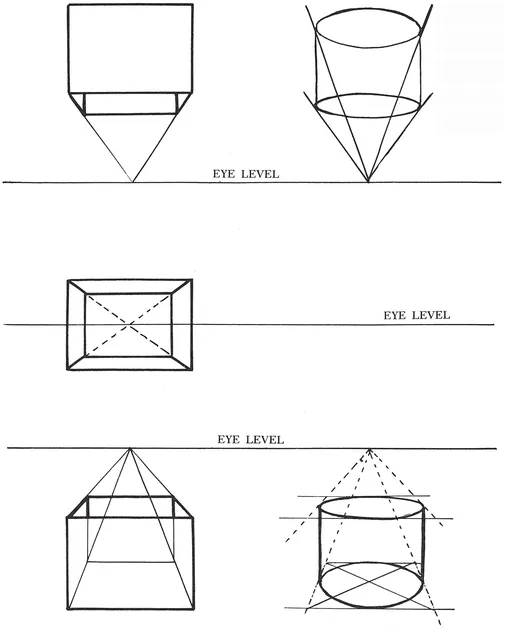
Apply these principles to any square object around you. Place a book in front of you without being able to see the sides but just the front and top and draw it using one point perspective. Try it with a table or chair or any six-sided square, then turn the same objects so you can see three sides – front, side, top using two point perspective.

All objects on this page are in two point perspective.
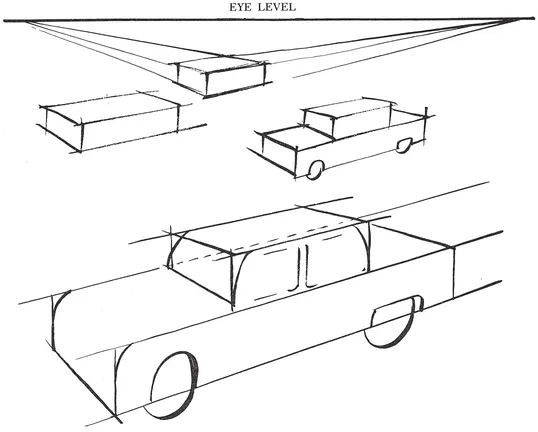
By placing one box over another and rounding the edges you have the basic perspective of a car.

SMALL BOX placed in front of long box gives you a locomotive in perspective.
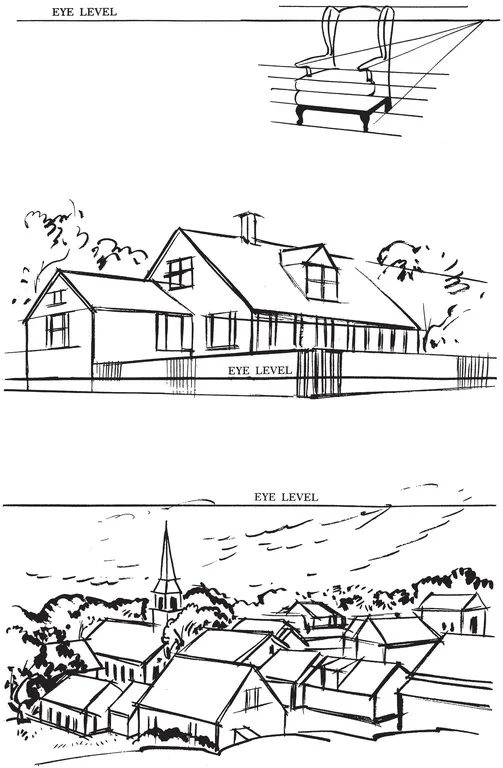
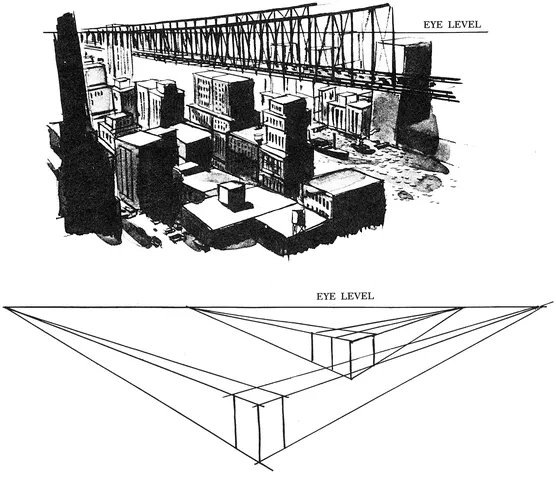
The photographs on this and the following pages are of two shipping departments filled with cartons. With the simple rule of perspective they are turned into two cities.

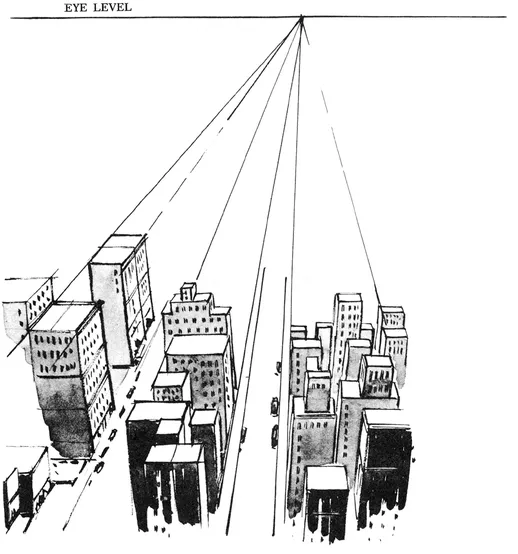

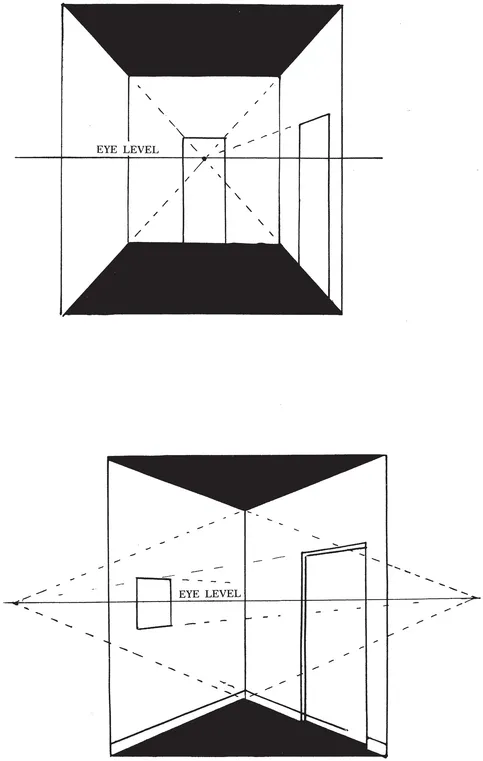
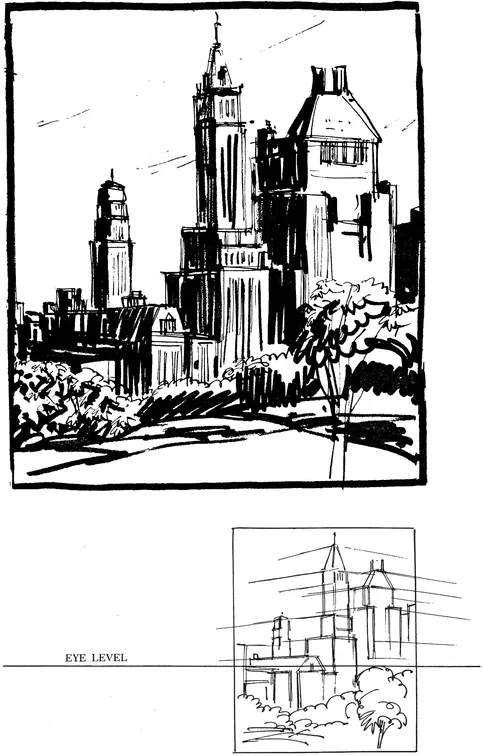
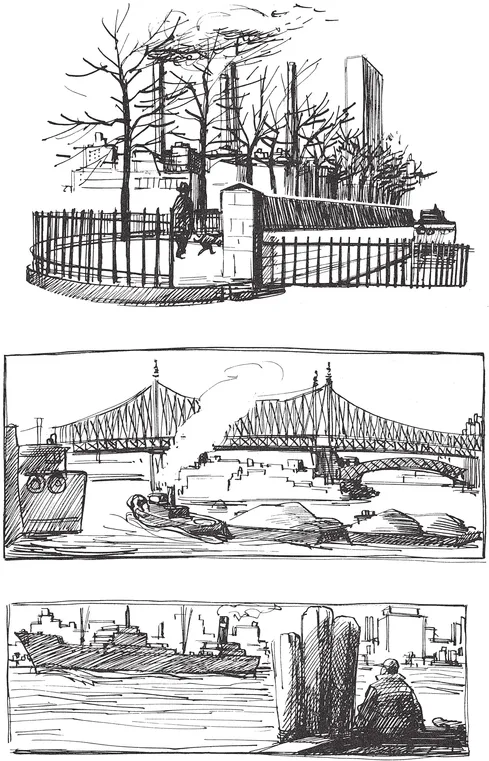
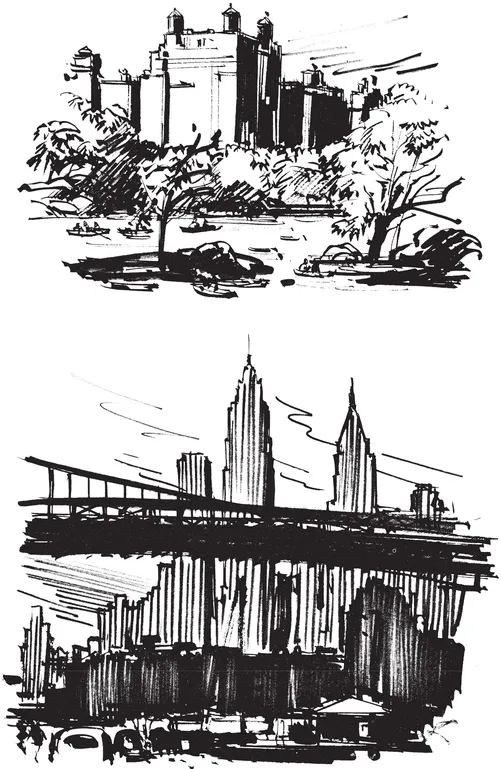
FIGURE IN PERSPECTIVE
In producing a picture with more than one figure, it is necessary to know how the figures in the background diminish in size. This is called the perspective of diminution. When you look at a string of telephone poles, the one farthest away appears smaller than the one nearest to you, even though all the poles are of the same length. Page 20 shows simple examples of how this rule of perspective is applied. On No. 1 the eye level is at the skaters’ knees. The parts of the figure that are above the eye level come down to the eye level and the parts of the figure below the eye level come to the same point on the eye level. Figures...